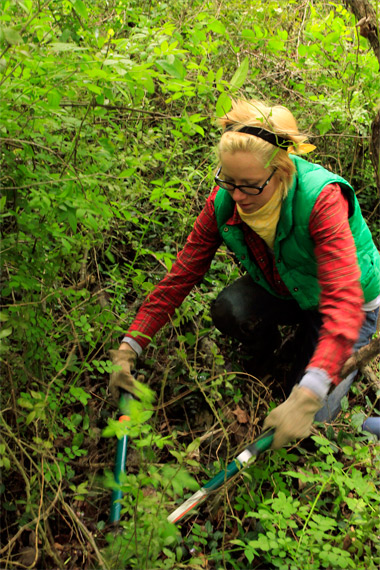
City trees -- Emily Hanson, a researcher in the Department of Forestry at Southern Illinois University Carbondale, examines the area around some trees recently. As a full-time urban and community forester based at SIU Carbondale, Hanson will help local governments throughout the state manage trees on public property. She will assist them in writing tree management plans, drafting city ordinances, conducting tree inventories and developing tree boards or committees that will watch over their communities’ tree populations. (Photo provided) Download Photo Here
May 30, 2012
Forester will help communities across the state
CARBONDALE, Ill. -- Forestry isn’t just for the forests.
A new member of the College of Agricultural Sciences at Southern Illinois University Carbondale will be working with local communities to help them better manage the “forests” that line their streets and populate their parks.
Emily Hanson, a researcher in the Department of Forestry, will reach out to communities as an urban and community forester. Two other forestry faculty members, Assistant Professor Eric Holzmueller and Professor John Groninger, won a grant to improve urban forestry managements from the U.S. Forest Service. The grant funds Hanson’s position, and she will work with communities all over the state, excluding the Chicago area.
Holzmueller and Groninger pursued the grant to promote better community forestry practices and policy within Illinois. The grant, and Hanson’s position will help establish a comprehensive information and education program in community forestry for both public agencies and private organizations at SIU Carbondale, perfectly complimenting the Department of Forestry’s educational efforts.
As a full-time urban and community forester, Hanson will help local governments manage trees on public property. She will assist them in writing tree management plans, drafting city ordinances, conducting tree inventories and developing tree boards or committees that will watch over their communities’ tree populations.
Although many local communities are rich in this treasure, they are sometimes taken for granted, Hanson said. Wooded yards increase property values, insulate homes from extreme heating and cooling costs and filter ground water. Benefits also include serving as locations for nature-based recreation, providing habitat for wildlife and simple aesthetics.
But like any living system, urban and community forests require care and management to ensure they thrive. Those local forests face many threats, including the Emerald Ash Borer epidemic, poor tree care that can lead to unsafe conditions, invasive exotic plants and even wildfire risks. Simple lack of knowledge of these and other threats at the local level can also present a great risk to the viability of local forestry.
With many communities facing budget shortfalls, Hanson said local forestry management is often one of the first areas to feel the knife. She hopes to counsel communities on the importance of maintaining baseline management practices that safeguard this valuable resource.
“Investing a little time and money in the urban forest will save the community in the long run,” she said. “For example, a little urban forest management can greatly reduce the number of trees that fall in a wind storm.”
Hanson also will work directly with community leaders and local boards on forest resources management issues to support community forestry management practices that complement community values. At times, when appropriate, she will help the communities receive public recognition for exemplary management activities.
Hanson said she has experience working with volunteers, training them to conduct major undertakings such as tree inventories. She also will work with communities to coordinate volunteers to conduct forestry related activities such as tree-planting events and invasive species control efforts.
Another aspect of Hanson’s duties will involve running educational programs and outreach. To this end, she will conduct regional community forestry workshops and seminars on topics such as proper tree planting and pruning techniques and how to avoid and mitigate construction damage, among others.
Even though most small communities don’t have the budgets to hire their own forestry personnel, they can accomplish a great deal with properly trained and motivated volunteers.
“With the right amount of training and optimism, volunteers are able to accomplish tasks that have traditionally been assigned to professionals or are otherwise ignored,” Hanson said. “It can be a relief to communities whose budgets are stretched thin.”
Hanson will visit many communities to conduct these tasks, but also will be available by phone and email to Illinois communities and individuals who have questions about their trees. She can be reached at 618/453-2517 and urban.forestry@siu.edu. For more information visit mypage.siu.edu/urban.forestry.
